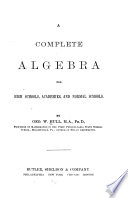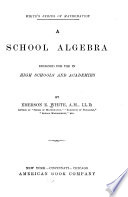 | William James Milne - Algebra - 1894 - 212 pages
...a result2x — 3 = л + 6 ing equation, x - 9. 9 — — с io "r, since a quantity may be changed from one member of an equation to the other by changing •" its sign (Prin.), — 3 may be transposed to the second member by changing it to + 3, and ж VERIFICATION. таУ... | |
 | George Washington Hull - Algebra - 1895 - 358 pages
...one member of the equation to the other, their signs are changed. Hence we have the following RULE. A term may be transposed from one member of an equation to the other if at the same time the sign be changed. EXAMPLES. Transpose and find the value of x in the following... | |
 | Emerson Elbridge White - Algebra - 1896 - 418 pages
...transposed to the second member if the sign — be changed to +. 143. In like manner it may be shown that any term may be transposed from one member of an equation to the other, provided its sign be changed. Thus, if 5a; — 8 = 16 + Зж, then 5x - 3x = 16 + 8. .-. 2 ж = 24,... | |
 | Webster Wells - Algebra - 1897 - 422 pages
...multiplied, or divided, by the same number, without destroying the equality. 72. Transposition of Terms. A term may be transposed from one member of an equation to the other by changing its sign. Let the equation be x + a — b. Subtracting a from both members (§ 71, 1), we have x = I — a. In... | |
 | William J. Milne - Algebra - 1899 - 172 pages
...by equals, the quotients are equal. 6. Equal powers of equal quantities are equal. 49. PRINCIPLE. A term may be transposed from one member of an equation to the other if its sign is changed from + to — , or from — to +. EQUATIONS AND PROBLEMS. 50. 1. Given 2x —... | |
 | James Harrington Boyd - Algebra - 1901 - 812 pages
...simple rules for solving the simple equations of the first degree. 1. Any quantity may In- transferred from, one member of an equation to the other by changing its sign. Thus, suppose (1) x— 3 = 9. Add 3 to each side by ¿81, 1 ; then ж — 3 + 3 = 9 + 3 that is, (2)... | |
 | William James Milne - Algebra - 1901 - 476 pages
...a term from one member of ал equation to the other is called Transposition. 72. PRINCIPLE. — A term may be transposed from one member of an equation to the other, provided its sign is changed. 73. A truth that does not need demonstration is called an Axiom. 74.... | |
 | Edward Brooks - Algebra - 1901 - 248 pages
...member to the other, the sign of the quantity is changed ; hence the following rule. , Role. — A term may be transposed from one member of an equation to the other, if, at the same time, the sign be changed. EXAMPLES. In the following examples transpose the known... | |
 | Robert Wahl, Max Henius - Brewing - 1902 - 1288 pages
...member. Example: ? + x = I*. Subtract 7 from both members. * = 12 — 7, or x = 5. It will be seen that a term may be transposed from one member of an equation to the other by changing its sign from + to — , or from — to +. The following rules are, therefore, obtained for solving a simple... | |
 | Frank Joseph Schneck - Business mathematics - 1902 - 288 pages
...of the equation to the other, and its sign has been changed from + to —. 52. Principle.—A number may be transposed from one member of an equation to the other by changing its sign from + to —, or from — to +. Solution of the Equation 53. If in any equation there is a term whose... | |
| |